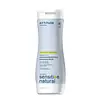What's inside
What's inside
 Key Ingredients
Key Ingredients

No key ingredients
 Benefits
Benefits

 Concerns
Concerns

 Ingredients Side-by-side
Ingredients Side-by-side

Colloidal Oatmeal Extract
HumectantWater
Skin ConditioningSodium C14-16 Olefin Sulfonate
CleansingCocamidopropyl Betaine
CleansingGlycol Distearate
EmollientHydrolyzed Milk Protein
Skin ConditioningPrunus Amygdalus Dulcis Seed Extract
Skin ConditioningPEG-7 Amodimethicone
HumectantPolyquaternium-22
Polyquaternium-39
PEG-150 Pentaerythrityl Tetrastearate
EmulsifyingPPG-2 Hydroxyethyl Cocamide
EmulsifyingAcrylates/C10-30 Alkyl Acrylate Crosspolymer
Emulsion StabilisingLaureth-4
EmulsifyingSodium Hydrolyzed Potato Starch Dodecenylsuccinate
Linoleamidopropyl Pg-Dimonium Chloride Phosphate
Propylene Glycol
HumectantCitric Acid
BufferingSodium Citrate
BufferingHexylene Glycol
EmulsifyingSodium Hydroxide
BufferingSodium Benzoate
MaskingParfum
MaskingColloidal Oatmeal Extract, Water, Sodium C14-16 Olefin Sulfonate, Cocamidopropyl Betaine, Glycol Distearate, Hydrolyzed Milk Protein, Prunus Amygdalus Dulcis Seed Extract, PEG-7 Amodimethicone, Polyquaternium-22, Polyquaternium-39, PEG-150 Pentaerythrityl Tetrastearate, PPG-2 Hydroxyethyl Cocamide, Acrylates/C10-30 Alkyl Acrylate Crosspolymer, Laureth-4, Sodium Hydrolyzed Potato Starch Dodecenylsuccinate, Linoleamidopropyl Pg-Dimonium Chloride Phosphate, Propylene Glycol, Citric Acid, Sodium Citrate, Hexylene Glycol, Sodium Hydroxide, Sodium Benzoate, Parfum
Water
Skin ConditioningSodium Coco-Sulfate
CleansingCoco-Glucoside
CleansingGlycerin
HumectantSodium Cocoyl Isethionate
CleansingLauryl Hydroxysultaine
CleansingCitric Acid
BufferingSodium Chloride
MaskingInulin
Skin ConditioningGlyceryl Oleate
EmollientSodium Benzoate
MaskingPotassium Sorbate
PreservativePanthenol
Skin ConditioningVitis Vinifera Seed Oil
EmollientGuar Hydroxypropyltrimonium Chloride
Skin ConditioningAvena Sativa Kernel Extract
AbrasiveHydrolyzed Soy Protein
HumectantWater, Sodium Coco-Sulfate, Coco-Glucoside, Glycerin, Sodium Cocoyl Isethionate, Lauryl Hydroxysultaine, Citric Acid, Sodium Chloride, Inulin, Glyceryl Oleate, Sodium Benzoate, Potassium Sorbate, Panthenol, Vitis Vinifera Seed Oil, Guar Hydroxypropyltrimonium Chloride, Avena Sativa Kernel Extract, Hydrolyzed Soy Protein
 Reviews
Reviews

Ingredients Explained
These ingredients are found in both products.
Ingredients higher up in an ingredient list are typically present in a larger amount.
Citric Acid is an alpha hydroxy acid (AHA) naturally found in citrus fruits like oranges, lemons, and limes.
Like other AHAs, citric acid can exfoliate skin by breaking down the bonds that hold dead skin cells together. This helps reveal smoother and brighter skin underneath.
However, this exfoliating effect only happens at high concentrations (20%) which can be hard to find in cosmetic products.
Due to this, citric acid is usually included in small amounts as a pH adjuster. This helps keep products slightly more acidic and compatible with skin's natural pH.
In skincare formulas, citric acid can:
While it can provide some skin benefits, research shows lactic acid and glycolic acid are generally more effective and less irritating exfoliants.
Most citric acid used in skincare today is made by fermenting sugars (usually from molasses). This synthetic version is identical to the natural citrus form but easier to stabilize and use in formulations.
Read more about some other popular AHA's here:
Learn more about Citric AcidSodium Benzoate is a preservative. It's used in both cosmetic and food products to inhibit the growth of mold and bacteria. It is typically produced synthetically.
Both the US FDA and EU Health Committee have approved the use of sodium benzoate. In the US, levels of 0.1% (of the total product) are allowed.
Sodium benzoate works as a preservative by inhibiting the growth of bacteria inside of cells. It prevents the cell from fermenting a type of sugar using an enzyme called phosphofructokinase.
It is the salt of benzoic acid. Foods containing sodium benzoate include soda, salad dressings, condiments, fruit juices, wines, and snack foods.
Studies for using ascorbic acid and sodium benzoate in cosmetics are lacking, especially in skincare routines with multiple steps.
We always recommend speaking with a professional, such as a dermatologist, if you have any concerns.
Learn more about Sodium BenzoateWater. It's the most common cosmetic ingredient of all. You'll usually see it at the top of ingredient lists, meaning that it makes up the largest part of the product.
So why is it so popular? Water most often acts as a solvent - this means that it helps dissolve other ingredients into the formulation.
You'll also recognize water as that liquid we all need to stay alive. If you see this, drink a glass of water. Stay hydrated!
Learn more about Water